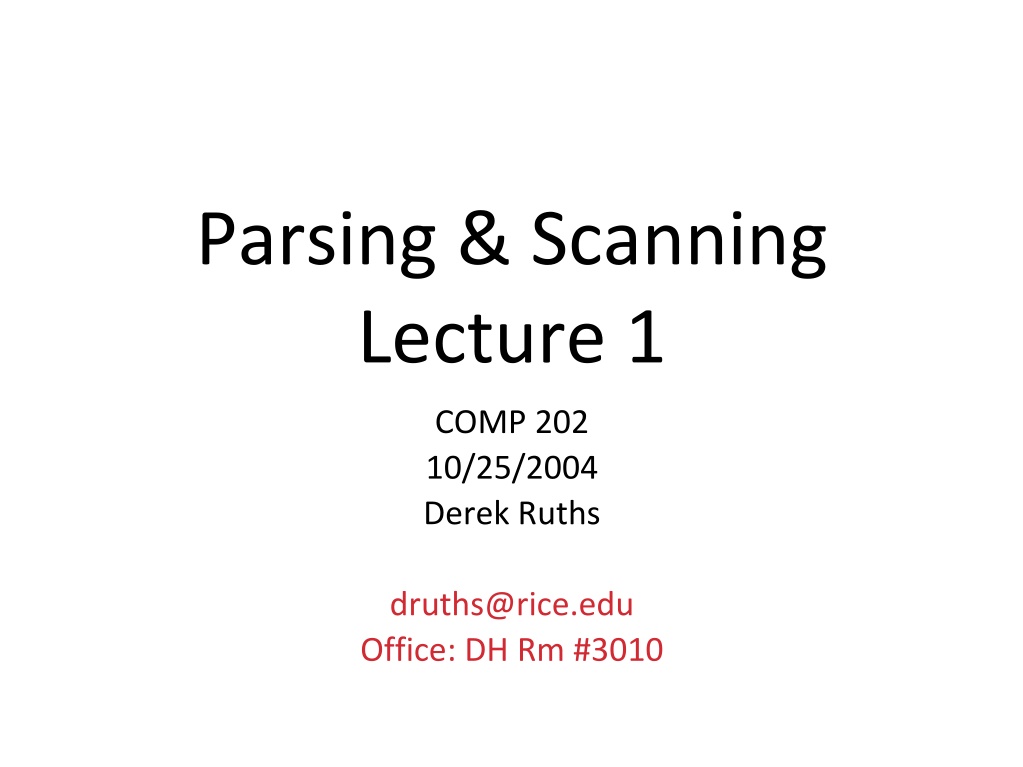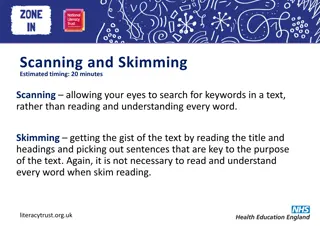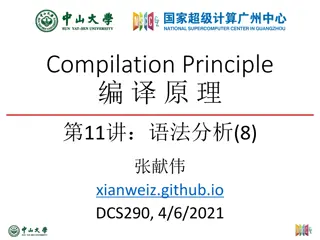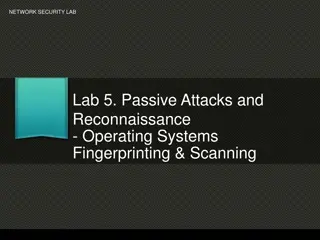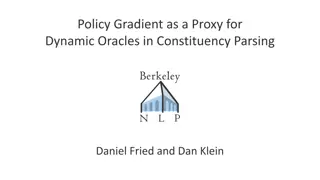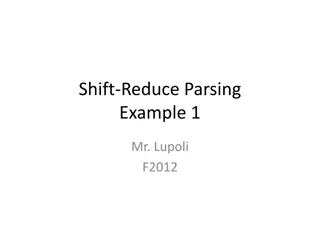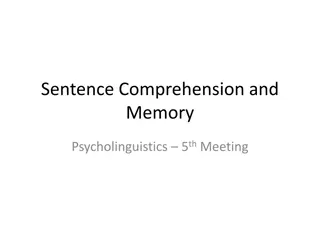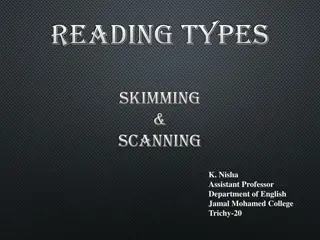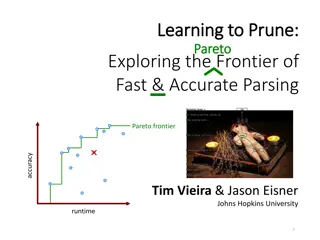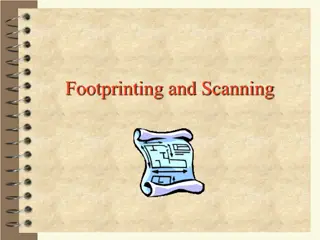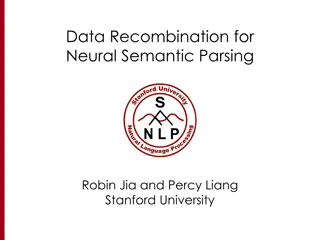Introduction to Parsing and Scanning
This lecture covers the fundamentals of parsing and scanning, exploring concepts such as breaking down into component parts of speech, building scanners, basic parsing theory, and structured representations like Abstract Syntax Trees. The content delves into the organization of grammar, token lists, and the process of manual scanning in Java, providing insights into speech recognition, games, IDEs, compilers, and interpreters within the context of computer science.
Download Presentation

Please find below an Image/Link to download the presentation.
The content on the website is provided AS IS for your information and personal use only. It may not be sold, licensed, or shared on other websites without obtaining consent from the author.If you encounter any issues during the download, it is possible that the publisher has removed the file from their server.
You are allowed to download the files provided on this website for personal or commercial use, subject to the condition that they are used lawfully. All files are the property of their respective owners.
The content on the website is provided AS IS for your information and personal use only. It may not be sold, licensed, or shared on other websites without obtaining consent from the author.
E N D
Presentation Transcript
Parsing & Scanning Lecture 1 COMP 202 10/25/2004 Derek Ruths druths@rice.edu Office: DH Rm #3010
Speech-Recognition Games IDEs Compilers/Interpreters
What is Parsing? Scanning parse (v.) to break down into its component parts of speech with an explanation of the form, function, and syntactical relationship of each part. --The American Heritage Dictionary Parsing
High-Level View Text, Source Code, Speech Structured Representation (e.g. Abstract Syntax Tree) Scanner Parser
Overview Lecture 1: Intro to scanning Intro to parsing Basics of building a scanner in Java Lab: Implementing a scanner Lecture 2: Basic Parsing Theory Design of an Object-Oriented Parser
High-Level View Text, Source Code, Speech Structured Representation (e.g. Abstract Syntax Tree) Scanner Parser
Scanning: Breaking Things Down Token List Token Type Token Value <NUM, 3 >, <PLUS, + >, <ID, x >, <EOF> 3 + x Scanner Character Stream Tokens
Scanning: Token List Tolkien List Token List Token Descriptor Token Type <NUM: [( 0 - 9 )+]> <OP: [ + , * ]> <ID: [alpha (alphaNum)*]> Tolkien Descriptor = Magical Powers Tolkien Type = Wizard
High-Level View (you saw this earlier) Text, Source Code, Speech Structured Representation (e.g. Abstract Syntax Tree) Scanner Parser
Parsing: Organizing Things Grammar <NUM, 3 >, <PLUS, + >, <ID, x >, <EOF> + Parser 3 x Abstract Syntax Tree Tokens
Manual Scanning in Java Token Value Token Type Token List <NUM, 3 >, <PLUS, + >, <ID, x >, <EOF> Scanner 3 + x Character Stream Tokens
Tokenizing Example public static final int PLUS = + ; public void tokenize(String str) { StreamTokenizer stok = new StreamTokenizer(new StringReader(str)); int token; Initialization stok.ordinaryChar(PLUS); stok.parseNumbers(); Configuration while((token = stok.nextToken()) != StreamTokenizer.TT_EOF) { switch(token) { case TT_WORD: System.out.println( WORD = + stok.sval); break; case TT_NUMBER: System.out.println( NUM = + stok.nval); break; case PLUS: System.out.printlN( PLUS ); break; } } Scanning }
Tokenizing Example public static final int PLUS = + ; Initialization public void tokenize(String str) { StreamTokenizer stok = new StreamTokenizer(new StringReader(str)); int token; stok.ordinaryChar(PLUS); stok.parseNumbers(); Configuration while((token = stok.nextToken()) != StreamTokenizer.TT_EOF) { switch(token) { case TT_WORD: System.out.println( WORD = + stok.sval); break; case TT_NUMBER: System.out.println( NUM = + stok.nval); break; case PLUS: System.out.printlN( PLUS ); break; } } Scanning }
java.io.StreamTokenizer Configuration: It s like programming a VCR! Token Type (int) Token Desc. How to Customize a word (no spaces) StreamTokenizer.TT_WORD void wordChars(int low, int high) a string quoted by qch int qch void quoteChar(int qch) e.g. quoteChar( : ) e.g. :hello there: is a quoted string StreamTokenizer.TT_NUMBER Numbers void parseNumbers() int ch the character value of ch void ordinaryChar(int ch) e.g. ordinaryChar( + ) e.g. (int) +
Tokenizing Example public static final int PLUS = + ; Initialization public void tokenize(String str) { StreamTokenizer stok = new StreamTokenizer(new StringReader(str)); int token; stok.ordinaryChar(PLUS); stok.parseNumbers(); Configuration while((token = stok.nextToken()) != StreamTokenizer.TT_EOF) { switch(token) { case TT_WORD: System.out.println( WORD = + stok.sval); break; case TT_NUMBER: System.out.println( NUM = + stok.nval); break; case PLUS: System.out.printlN( PLUS ); break; } } Scanning }
java.io.StreamTokenizer Scanning: It s like calling nextToken over and over! Call int StreamTokenizer.nextToken() to get the next token. String StreamTokenizer.sval (public field) holds the token value for TT_WORD and quote token types double StreamTokenizer.nval (public field) holds the token value for TT_NUMBER token type
Tokenizing Example public static final int PLUS = + ; Initialization public void tokenize(String str) { StreamTokenizer stok = new StreamTokenizer(new StringReader(str)); int token; Configuration stok.ordinaryChar(PLUS); stok.parseNumbers(); while((token = stok.nextToken()) != StreamTokenizer.TT_EOF) { switch(token) { case TT_WORD: System.out.println( WORD = + stok.sval); break; case TT_NUMBER: System.out.println( NUM = + stok.nval); break; case PLUS: System.out.printlN( PLUS ); break; } } Scanning }
java.io.StreamTokenizer Initialization: It s like using Java I/O! Constructor: StreamTokenizer(Reader r) java.io.Reader - class for reading bytes FileReader - read bytes from a File StringReader - read bytes from a String
